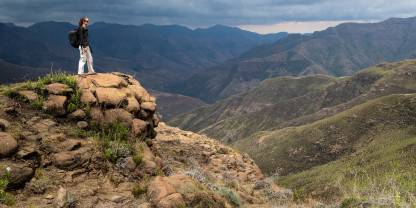Average Expert Rating
Rating Breakdown
Write a User ReviewA luxury retreat in a wild mountain setting
Ts’ehlanyane National Park is one of Lesotho’s top attractions. Its center is Maliba Lodge, one of the best hotels in the country. The combination of great hiking opportunities and a lovely place to stay makes this a winning destination. The trails are well marked but guides are available upon request. We set out early to tackle the 16km ‘Circular Route’ which takes in a cascading waterfall, a forested valley, bubbling mountain streams and several spectacular viewpoints. The cherry on top was a small herd of eland, which ran for cover as soon as they spotted us. The rugged high-altitude mountainous terrain makes for challenging hiking conditions, and the massive thunderstorm, which came out of nowhere, added to our adventure. Back at the lodge, we enjoyed a hearty dinner and a good bottle of wine in front of a roaring log fire. I further rewarded myself with a therapeutic massage treatment at the outdoor spa nestled amongst indigenous forest. I left rejuvenated and knew I would be back one day to discover more of this stunning park, perhaps on horseback.
A Luxury Lodge With Spellbinding Landscapes and Breathtaking Trekking
Nevertheless, you don’t come to such a beautiful spot to spend time
Read more
sitting inside. I went out at 6am one morning for a guided birding tour with Maliba’s excellent resident bird guide. Malachite sunbirds, southern boubous and those lovely Cape canaries were among the favourite sightings. On another morning I went for a pre-breakfast hike around what is known as the Circular Trail and for an invigorating dip in the Lets’a Lets’o (Black Pool) under a chilly cascade. Horse riding is another favourite activity at Ts’ehlanyane, but be sure to visit the local community too since Lesotho is all about culture.Maliba works closely with schools and health projects so you can be sure that your holiday budget is being used to support what was traditionally an under-represented community. My community tour was guided by the very informative and enthusiastic Ratia (who also does horseback guiding). We gained a unique insight into Lesotho culture through local rondavel architecture, a shebeen with (absolutely delicious) locally brewed sorghum beer and a fascinating ‘consultation’ with Mrs Malebohang, who’s served as the most celebrated regional sangoma (medicine woman) for decades.
Lesotho’s Most Accessible Hiking & Wildlife Destination
Ts’ehlanyane’s main attraction is the mountain scenery and flora. Although the park is only 56km2/22mi2 in extent, altitudes range from 1,940m to 3,110m (6,365ft to 10,203ft), and it is flowed through by four substantial rivers. Maliba Lodge, the main tourist focal point, is accessible on a good gravel road, but the rest of the park can be explored only on foot or horseback along a network of well-marked hiking trails.
We hiked the longest of these routes, the six-hour, 16km/10mi Circular Trail, which is relatively
Read more
easy underfoot and took us past some lovely spring flower displays. A few steeper sections of the trail can be quite demanding, especially if – as happened to us – you’re doused in a summer rainstorm complete with squalls of hail.An early highlight of the Circular Trail, Lets’a Lets’o (Black Lake) is a pretty natural swimming pool set above a waterfall on the Ts’ehlanyane River. This river, like the park itself, shares its Sotho name with the berg bamboo Thamnocalamus tessellatus clumped along its banks. The only species of bamboo to occur naturally in Lesotho or South Africa, the berg bamboo is endemic to the Maloti-Drakensberg Mountains, where Ts’ehlanyane National Park is now its main stronghold.
Another highlight of the Circular Trail is a viewpoint across to the Matsa Mararo Falls, which cascade down a tall soaring vertical face in three tiers, each with a large pool at its base.
Of the 20-odd mammal species protected in Ts’ehlanyane National Park, we had some good sightings of the majestic eland (the world’s largest antelope) and also saw plenty of rock hyraxes. I found the park’s most rewarding birding habitat to be the dense tract of low riverine forest comprised almost entirely of Leucosidea sericea, a gnarled evergreen tree known locally as Ouhout (Old Wood). Birds to look out for here include bush blackcap, southern boubou, Cape batis and malachite sunbird.

